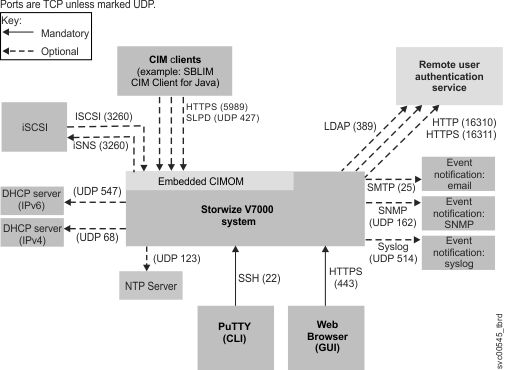Plan your installation, considering TCP/IP address requirements and service access.
To plan your installation, use Table 1 and consider the TCP/IP address requirements of the Lenovo Storage V7000clustered system and the requirements for the Lenovo Storage V7000 to access other services. You must also plan for the Ethernet address allocation, and for the configuration of the Ethernet router, gateway and firewall.

| Service | Traffic direction | Protocol | Port | Service type |
|---|---|---|---|---|
| Email (SMTP) notification and inventory reporting | Outbound | TCP | 25 | optional |
| SNMP event notification | Outbound | UDP | 162 | optional |
| Syslog event notification | Outbound | UDP | 514 | optional |
| IPv4 DHCP (Node service address) | Outbound | UDP | 68 | optional |
| IPv6 DHCP (Node service address) | Outbound | UDP | 547 | optional |
| Network time server (NTP) | Outbound | UDP | 123 | optional |
| SSH for command line interface (CLI) access | Inbound | TCP | 22 | mandatory |
| HTTPS for GUI access | Inbound | TCP | 443 | mandatory |
| CIMOM (HTTPS) | Inbound | TCP | 5989 | optional |
| CIMOM SLPD | Inbound | UDP | 427 | optional |
| Remote user authentication service - HTTP | Outbound | TCP | 16310 | optional |
| Remote user authentication service - HTTPS | Outbound | TCP | 16311 | optional |
| Remote user authentication service - Lightweight Directory Access Protocol (LDAP) | Outbound | TCP | 389 | optional |
| iSCSI | Inbound | TCP | 3260 | optional |
| iSCSI iSNS | Outbound | TCP | 3260 | optional |
| IP Partnership management IP communication | Inbound | TCP | 3260 | optional |
| IP Partnership management IP communication | Outbound | TCP | 3260 | optional |
| IP Partnership data path connections | Inbound | TCP | 3265 | optional |
| IP Partnership data path connections | Outbound | TCP | 3265 | optional |
Both IPv4 and IPv6 addresses are supported. Lenovo Storage V7000 can operate with either internet protocol or with both internet protocols concurrently.
For configuration and management, you must allocate an IP address to the system, which is referred to as the management IP address. For additional fault tolerance, you can also configure a second IP address for the second Ethernet port on the node.The addresses must be fixed addresses. If both IPv4 and IPv6 are operating concurrently, an address is required for each protocol.
In addition to the management IP addresses, the system is configured with one or more service IP addresses.Service IP addresses are used to gain access to the service assistant when a node is not operating correctly as part of the system. As with the management IP addresses, service IP addresses can be IPv4 addresses, IPv6 addresses, or both. You should choose a fixed IP address per Ethernet port, or you can configure Lenovo Storage V7000 to use a DHCP-allocated address.
Any system that accesses the service IP address must be able to access a management IP address, or a dynamically-allocated service address if DHCP is used.
You can configure Lenovo Storage V7000 for event notification by SNMP, syslog or email. To configure notification, you must ensure that the SNMP agent, syslog IP addresses or SMTP email server IP addresses can be accessed from all Lenovo Storage V7000management addresses.
Lenovo Storage V7000 does not use name servers to locate other devices. You must supply the numeric IP address of the device. To locate a device, the device must have a fixed IP address.
The nodes in a Lenovo Storage V7000system can receive native IPv4 or IPv6 packets. The nodes cannot operate as an endpoint of a tunnel where an IPv4 packet contains an IPv6 payload or where an IPv6 packet contains an IPv4 payload.
- IPv6 for iSCSI data traffic (to Control Enclosure) is supported
- IPv6 for Management is not supported.